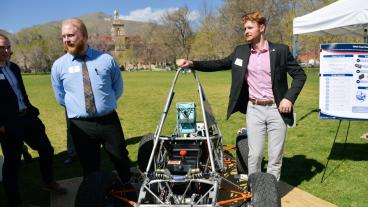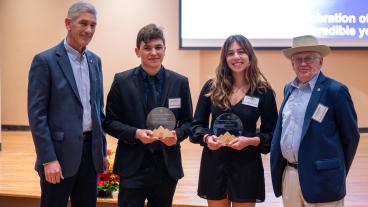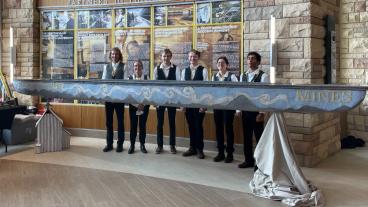This story appears in the 2014-15 issue of Mines' research magazine, "Energy & the Earth."
Colorado School of Mines has been known for its prowess in geology since about 1874. Its reputation in biotechnology has taken just a little bit longer to develop – about 130 years longer, give or take.
Mines is making up for lost time. The school’s faculty, researchers and students haVe shed new light on areas as diverse as the nature of blood clots and the microbial role in rust. They have helped make better artificial limbs and developed laser microscopes capable of capturing video of the inner working of cells. They have reengineered algae to produce biofuels and developed scaffolding that could one day give new cartilage a foothold in creaky knees. In short, biological sciences and engineering have arrived at Mines, and in a big way.
The work is diverse, but there are common threads, said David Marr, who heads Mines’ Department of Chemical and Biological Engineering.
“We are an engineering and technology-focused institution— that’s really where our niche is,” Marr said. “It’s in areas of bioengineering, broadly interpreted, that we have a strong role to play.” Those areas, he added, encompass biomedical applications, biomechanics, biomaterials, environmental biotechnology and biofuels.
Recent hires have bolstered several of these research areas, and curriculum has changed in kind, with courses covering a range of biomedical engineering, biomaterials, environmental biotechnology and biophysics available to undergraduate as well as graduate students. In fall 2013, Mines’ freshman biology course moved to a studio format, where small teams of students sit at workstations equipped with computers, dual monitors, video microscopes, digital cameras and digital balances, as well as with more specialized equipment like micropipettes and oxygen, pH and temperature sensors.
Mines Assistant Professor Nanette Boyle is among the recent arrivals, having signed on in August 2013. Like many at Mines, Boyle considers herself an engineer. But she engineers the genomes of algae and cyanobacteria, microscopic plants using the tools of synthetic biology, systems biology and metabolic engineering.
“The overall goal of my research is to make products that replace petroleum using these photosynthetic organisms,” Boyle said.
In her new Alderson Hall lab, stacked incubator shakers swirled the contents of four beakers, their sloshing fluid of varying light green hues under the bright multispectral light. They were filed with the algae Chlamydomonas and the cyanobacteria Synechococcus. Boyle’s work differs from most algae-based biofuel efforts, which aim to fatten up the algae and then harvest them. Rather, she wants to engineer the algae to produce short chain alcohols, isoprene or other hydrocarbons while they keep photosynthesizing away.
“You can get them to create whatever you want if you can find the genes to do it,” Boyle said.
Mines Professor John Spear, a microbiologist, also focuses on the genomics of tiny creatures. The driving questions of his work, though, are big.
“What are the possible benefits of microbes to make human life and/or the environment better?” Spear asked. “How can we put microbes to work in ways we haven’t done before?”
Genetic sequencing has fostered an explosion in what is known of the tree of life, and Spear and colleagues are discovering new organisms at a dizzying pace. In the mid-1980s, there were perhaps 12 known phyla, or kingdoms, of bacteria. Now there are 130 and counting.
“So when you find 10 or 20 phyla of bacteria as we have found in some environments, that’s like walking out your door and discovering plants for the first time,” Spear said.
On the applied side, Spear has focused on a couple of areas, including wastewater treatment and corrosion. Some corrosion is chemical, but microbes, which feed on the electrons metal has to offer, also contribute, to the point that the oil and gas industry has considered flushing wells with antibiotics. Across industry, the failures and replacement costs associated with corrosion cost tens of billions of dollars annually. More precisely understanding the composition and habits of such microbes can help industry develop better countermeasures and lower costs, Spear said.
Much of Mines’ biology-related work involves the biomedical field. A longstanding collaboration involving Marr and Associate Professor Keith Neeves, recently landed a National Institutes of Health grant to study how microbots – tiny spherical machines each about onetwentieth the diameter of a human hair – might be used to deliver clot-busting drugs straight to the blockage in stroke patients. The idea, Marr said, is to inject a swarm of microbots and steer them to clots using magnets outside the body, “A sort of ‘Fantastic Voyage’ kind of thing,” Marr said.
Marr’s Alderson lab has the markings of an experimental physicist’s haunts, with stainless-steel-topped laser tables rife with grids of screw holes, many anchoring lenses and mirrors. The work there focuses on using light and magnetism to, among other things, test the mechanical properties of cells. A floor below, Neeves’ PhD student Abimbola Jarvis bounced between making microfluidic devices of rubbery silicone and adjusting an Olympus microscope where the screen displayed a fluorescence-enhanced time-lapse of a blood clot forming. Neeves’ main interest is in how blood clots form and dissolve, work that has piqued the interest of clinicians at places such as Children’s Hospital Colorado, where Neeves has helped study hemophilia patients.
“We work where physics and hematology meet,” Neeves said.
Down the hall, Assistant Professor Melissa Krebs is working on where joints meet, among other things. She and her students create biopolymers with applications ranging from tissue regeneration (cartilage being one target) to cancer fighting. The trick, she said, is to create polymers that support cell growth or drug delivery for a prescribed amount of time and then dissolve away.
In Krebs’s lab, PhD student Michael Riederer was creating microspheres for use on the drug-delivery side. Among the inputs were genipin, a chemical derived from gardenias, and chitosan from shrimp shells. As the research progresses, he will work on releasing proteins from the microspheres, controlling the pace and volume of release, Krebs said. These proteins might include growth factors for tissue regeneration or growth inhibitors for cancer treatment, she said.
Mines Assistant Professor Anne Silverman works on joints, too, but from a different perspective. With Mines associate professors Anthony Petrella and Joel Bach, she leads Mines’ Center for Biomechanics & Rehabilitation Research.
“The overall theme is improving walking ability in people who have movement disorders,” Silverman said.
Her team takes experimental measurements on patients using near-infrared cameras, voltage sensors to measure muscle excitations and force plates to measure external loads (such as the heel hitting the ground). They then use this data to develop computer simulations of movement. Amputations below the knee have been a focus, but her team also works with patients who have Parkinson’s disease and cerebral palsy. Collaboration partners have ranged from the Center for the Intrepid at Brooke Army Medical Center and the Colorado Neurological Institute at Denver’s Swedish Medical Center.
“We’re creating complex models and simulations of movement to estimate in vivo muscular and joint behavior,” Silverman said. “We’re using an engineering approach to solve biological problems.”



